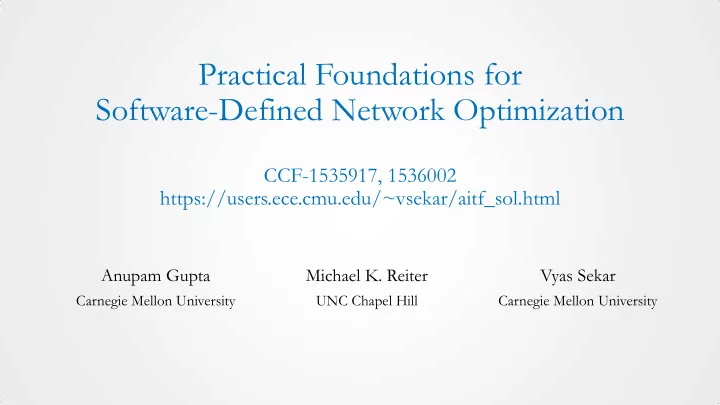

Practical Foundations for Software-Defined Network Optimization CCF-1535917, 1536002 https://users.ece.cmu.edu/~vsekar/aitf_sol.html Anupam Gupta Michael K. Reiter Vyas Sekar Carnegie Mellon University UNC Chapel Hill Carnegie Mellon University
A 20000 feet view of Software-Defined Networking (SDN) Centralized management + Open config APIs OpenFlow: Controller Pkt header, Interface Forwarding interface “ Flow ” FwdAction “ Flow ” FwdAction … … … … “ Flow ” FwdAction … … 2
What SDN looks like functionally? SDN applications A A A A A A A Network routes Network data Control Platform (e.g., ONOS, OpenDaylight) Data plane 3
Network Optimizations are Common • Maxflow, Traffic engineering • SIMPLE (SIGCOMM 2013) • ElasticTree (NSDI 2010) • Panopticon (Usenix ATC 2014) • SWAN (SIGCOMM 2013) 4
Current Process Not fast Take theory & Formulate the Solve with a enough optimization problem solver courses • NP hard? Develop Deploy Parse solution heuristic 5
Our Vision: Practical Foundations for SDN optimization SDN applications • Focus on high-level A A A A A A A network goals • Rapid prototyping Optimization layer Network routes Network data • App = 20 lines of Control Platform (e.g., ONOS, OpenDaylight) code 6
Project scope and goals • Completed: Framework to simplify basic SDN app development • New abstractions and rule synthesis tools • [NSDI’16] paper and open source tool https://github.com/progwriter/SOL • Future • Support composition of applications • Advanced abstractions beyond basic apps • Support for stochastic/adversarial demands 7
SOL Framework to simplify workflow Approach Generality Efficiency ✓ ✗ Frameworks ✗ ✓ Custom solutions ✓ ✓ SOL
SOL: S DN O ptimization L ayer SDN applications Diverse set A A A A A A A SOL API Optimization solver SOL (e.g., CPLEX) Logically centralized Network data Network routes Control Platform (e.g., ONOS, OpenDaylight) 9
Insight: Path Abstraction • Problems are recast to be path-based • Policies are path predicates 10
Path-based Recasting: MaxFlow Edge-based Path-based 1 3 𝑔 : amount of flow 𝑔 𝑞1 s t 1 𝑔 𝑓3 𝑔 s t 𝑞2 𝑔 𝑔 𝑓7 𝑓1 1 3 𝑔 𝑓4 4 s t 𝑔 𝑓5 … 𝑔 𝑓2 𝑔 𝑓8 4 2 1 3 𝑔 𝑓6 s t 𝑔 𝑞𝑙 4 2 𝑔 𝑓1 = 𝑔 𝑓3 + 𝑔 𝑓4 𝑙 𝑔 = demand 11 𝑞𝑗 𝑗=1
Policies as Path Predicates IPS Valid paths : • N1-N4-N5 N1 N3 N1 →N5 N5 • N1-N3-N4-N5 Web, 100 Mbps Invalid paths : FW→Proxy Proxy • N1-N3-N5 N2 N4 IPS FW Generality 12
Path Challenge Exponential number of paths Large optimization size Long run time = Bad efficiency 13
SOL Process Path Rule Path generation Optimization selection generation 1. Enumerate all simple paths Pick a subset of paths 1. Model resource usage 2. Keep valid paths Use a controller to and constraints (according to a predicate) configure data plane paths This acts as a heuristic 2. Solve Offline step Efficiency 14
Implementation • Python library; interfaces with CPLEX solver and ONOS controller • Prototyped applications • MaxFlow, Traffic engineering, latency minimization • ElasticTree ( Heller et al. ), Panopticon ( Levin et al. ), SIMPLE ( Qazi et al. ) 15
Example: MaxFlow Topology input Path generation + selection opt, pptc = initOptimization(topo, trafficClasses, nullPredicate, 'shortest', 5) 1. Traffic flows opt.allocateFlow(pptc) 2. linkcapfunc = lambda link, tc, path, resource: tc.volBytes Resource 3. consumption opt.capLinks(pptc, 'bandwidth', linkConstrCaps, linkcapfunc) 4. opt.maxFlow(pptc) Global goal (objective function) 5. opt.solve() 6. 16
Example: Traffic Engineering opt, pptc = initOptimization(topo, trafficClasses, nullPredicate, 'shortest', 5) 1. opt.allocateFlow(pptc) 2. linkcapfunc = lambda link, tc, path, resource: tc.volBytes 3. opt.capLinks(pptc, 'bandwidth', linkConstrCaps, linkcapfunc) 4. opt.routeAll(pptc) 5. Route all traffic opt.minLinkLoad('bandwidth') 6. Minimize bandwidth load opt.solve() 7. 17
Development effort Application SOL lines of code Estimated improvement 21.8× ElasticTree ( Heller et al. ) 16 25.7× Panoption ( Levin et al. ) 13 SIMPLE ( Qazi et al. ) 21 18.6× 18
Optimization Runtime Log Scale • Orders of magnitude Shaded: No solution faster by the original within • Less than 1% away 30 minutes from optimal Topology (number of switches) 19
Open questions and next steps? • When/why does path pruning work? • What is a good pruning strategy for a given objective/topology? • Robustness to varying demands? • Enabling composition of apps? • Are paths sufficient or do we need richer abstractions? 20
Broader efforts in this space .. AitF-funded workshop on Algorithms for Software-Defined Networking Thanks to Mike Dinitz,Thyaga, Tracy, Rebecca Wright! At DIMACS, Jun 2-3 2016 Program: http://dimacs.rutgers.edu/Workshops/SDNAlgorithms/program.html Videos! https://www.youtube.com/playlist?list=PLqxsGMRlY6u7BhnI6JxShJHj_tYg- i1Qh 21
Conclusions • SDN benefits in the field requires optimization • Vision: Practical foundations for SDN optimization Lower barrier of entry for developers • Initial work on SOL: • Leverages the path abstraction: generation + selection • Efficient: deploy in seconds! • Enabler for new directions • E.g., seamless composition • Many open theoretical questions with practical implications in SDN space 22
Recommend
More recommend